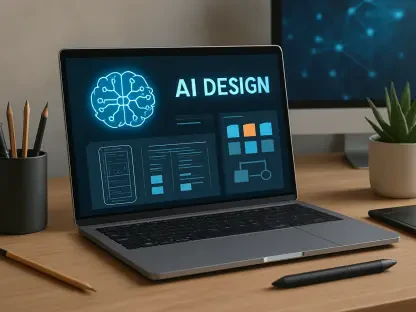Overview of the Tech Industry and AI’s Influence
The tech industry stands as a cornerstone of the global economy, with its staggering growth reshaping how businesses operate and societies function. Valued at trillions of dollars, this sector drives innovation across multiple domains, from communication to healthcare, with artificial intelligence (AI) emerging as a transformative force. The rapid integration of AI technologies has sparked a wave of advancements, but it also brings unprecedented challenges, as highlighted by Okta, a leading identity management company, which has raised alarms over escalating AI-driven cyber threats.
A closer look at the industry reveals key segments like cloud computing, cybersecurity, and AI-driven solutions leading the charge. These areas are not just growing; they are redefining competitive landscapes with their ability to scale operations and enhance efficiency. Major players such as Amazon, Microsoft, and Nvidia are pouring billions into AI research and development, positioning themselves at the forefront of this technological revolution.
The pervasive adoption of AI extends beyond tech giants, influencing sectors as diverse as manufacturing, retail, and finance. This widespread integration fuels innovation, enabling smarter decision-making and personalized consumer experiences. However, it also amplifies risks, setting the stage for a critical examination of how AI shapes market dynamics and security concerns in an increasingly digital world.
AI’s Expansion and Market Dynamics
Trends Driving AI Adoption
AI’s rise is propelled by strategic partnerships and monumental investments that underscore its strategic importance. A notable example is Amazon’s $38 billion deal with OpenAI, a collaboration aimed at enhancing cloud-based AI capabilities. Such agreements reflect a broader trend of tech firms aligning with specialized AI innovators to accelerate product development and market reach.
Emerging technologies, including advanced machine learning algorithms and seamless AI integration into consumer applications, are reshaping user expectations. From virtual assistants to predictive analytics in shopping platforms, these tools are becoming ubiquitous, driving both convenience and engagement. This shift is particularly evident in how businesses leverage AI to anticipate customer needs and optimize operations.
Market drivers like evolving consumer behavior and new opportunities in sectors such as energy and finance further fuel AI’s momentum. In energy, AI is optimizing grid management, while in finance, it powers fraud detection and algorithmic trading. These cross-industry applications highlight AI’s versatility, creating fertile ground for innovation but also raising questions about scalability and oversight.
Performance Metrics and Growth Forecasts
Financial markets reflect strong optimism for AI, with companies like Amazon and Nvidia experiencing significant stock surges following robust earnings tied to AI initiatives. These gains signal investor confidence in AI’s potential to generate long-term value, with market analysts projecting substantial growth over the next few years, from this year to 2027.
Yet, this enthusiasm is tempered by volatility in tech indices like the Nasdaq, which has seen declines of nearly 2% amid fears of overvaluation in AI-focused stocks. Such fluctuations reveal a cautious undercurrent among investors, who worry that inflated valuations could lead to a market correction if expectations outpace tangible results.
Looking ahead, AI’s growth trajectory appears promising but not without hurdles. Economic uncertainties and escalating cybersecurity risks pose significant challenges to sustained expansion. Industry forecasts suggest that while AI will continue to drive tech sector gains, businesses must navigate these risks with strategic planning to maintain stability and capitalize on emerging opportunities.
Challenges and Vulnerabilities in AI Deployment
Okta’s recent cautionary stance on AI-driven cyber threats brings critical issues into sharp focus. The company warns of sophisticated phishing attacks, deepfake impersonations used for fraud, and automated hacking attempts powered by machine learning. These threats exploit AI’s capabilities to mimic human behavior, making them harder to detect and counter.
Beyond cybersecurity, the tech sector faces broader challenges, including concerns over a potential market bubble fueled by high valuations of AI-centric stocks. Investors are increasingly wary, as seen in actions like prominent hedge funds taking positions against tech giants, signaling skepticism about the sustainability of current market trends. This financial uncertainty compounds the operational risks businesses face.
Addressing these challenges requires a multifaceted approach, including the adoption of robust cybersecurity frameworks and strategic risk management practices. Companies must invest in advanced threat detection systems and employee training to mitigate AI-enabled attacks. Simultaneously, market stakeholders need to balance hype with realistic assessments of AI’s value to prevent economic fallout from overinflated expectations.
Regulatory and Policy Impacts on AI Development
The regulatory environment surrounding AI remains fluid, with significant uncertainties stemming from monetary policy decisions by institutions like the Federal Reserve. Debates over interest rates and inflation control directly affect tech investments, as higher borrowing costs can constrain the capital-intensive nature of AI development and deployment.
Geopolitical tensions add another layer of complexity, with actions such as China’s policy adjustments on rare earth exports and investigations into U.S. chip manufacturers impacting global supply chains. These developments create ripple effects across the tech industry, influencing everything from hardware availability to international collaboration on AI projects.
Domestic policy discussions also play a pivotal role in shaping the tech landscape. Ongoing debates over innovation incentives and data privacy laws affect how companies approach AI integration. Compliance with evolving regulations and a strong emphasis on security measures are essential to prevent misuse of AI technologies and sustain consumer trust in digital ecosystems.
Future Horizons for AI and Tech Innovation
AI’s trajectory points toward continued evolution, with emerging technologies poised to disrupt traditional models. Innovations like generative AI and autonomous systems are expected to redefine industries, offering solutions to complex problems while introducing new competitive dynamics. Keeping pace with these advancements will be crucial for market leaders.
Consumer preferences are shifting under economic pressures, influencing demand for AI-driven products and services. As disposable income faces constraints from inflation and debt, tech firms must adapt by offering cost-effective solutions or targeting niche markets. This adaptability will determine how effectively AI can penetrate diverse consumer segments.
Exploration of new frontiers, such as AI’s role in sustainable energy solutions and financial tokenization, underscores its potential to transform adjacent sectors. However, global economic conditions and regulatory developments remain key variables. How these factors unfold will significantly shape AI’s capacity to drive growth and address pressing societal challenges in the coming years.
Closing Reflections and Strategic Recommendations
Looking back, the discourse on AI’s role in the tech industry reveals a landscape of immense opportunity shadowed by significant risks. Okta’s warning about cyber threats serves as a critical reminder that innovation must be paired with vigilance to protect digital infrastructures from evolving dangers.
The analysis of market trends and regulatory challenges highlights the delicate balance companies must strike between aggressive AI adoption and prudent risk management. Volatility in financial markets and geopolitical uncertainties further underscore the complex environment in which tech firms operate.
Moving forward, stakeholders must prioritize actionable strategies, such as investing in cutting-edge cybersecurity defenses and fostering transparent dialogue with regulators to shape favorable policies. Emphasizing ethical AI development can also build public trust, ensuring long-term sustainability. As the tech sector evolves, a collaborative approach among industry leaders, policymakers, and investors will be vital to harness AI’s potential while safeguarding against its pitfalls.









